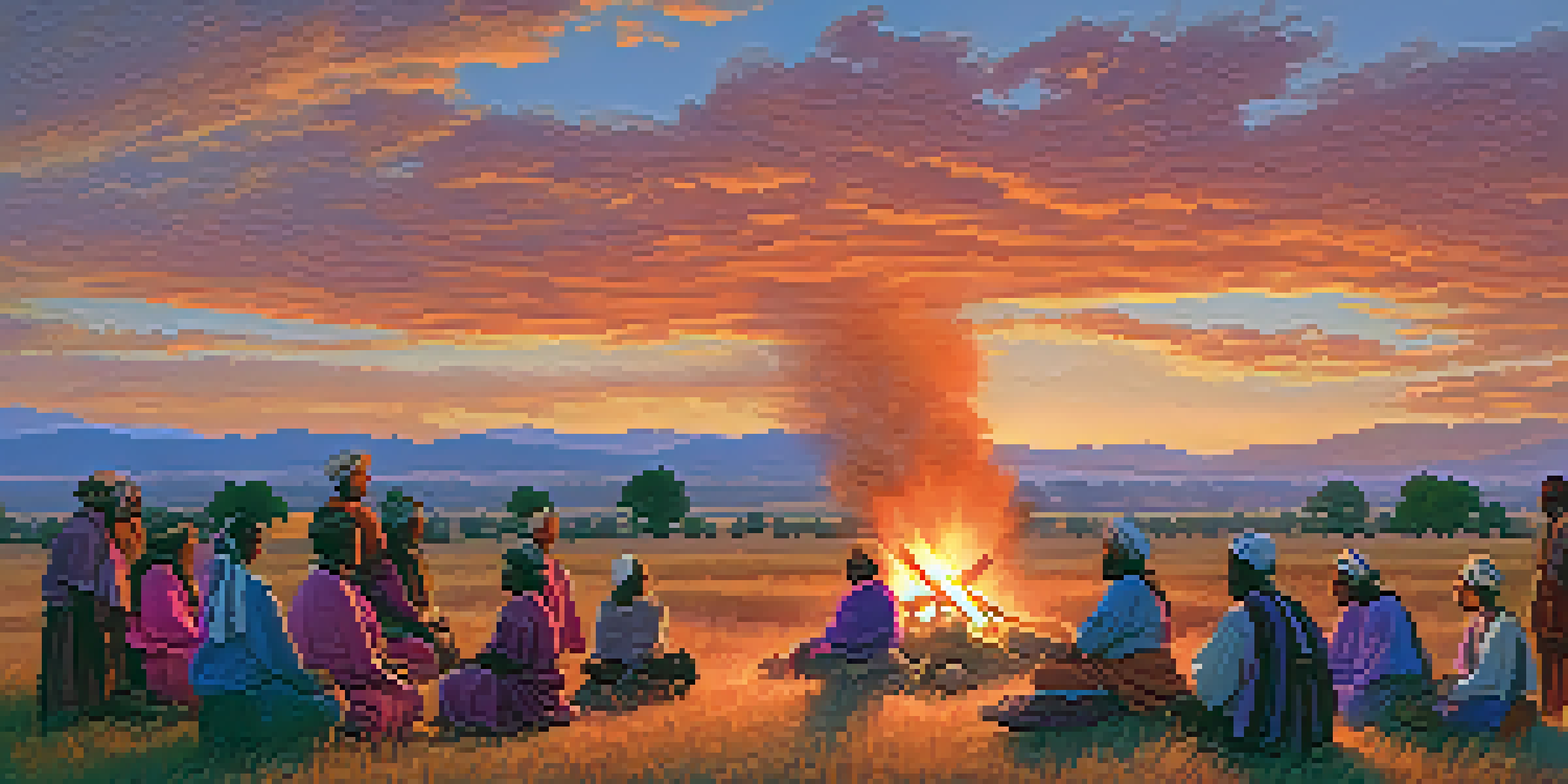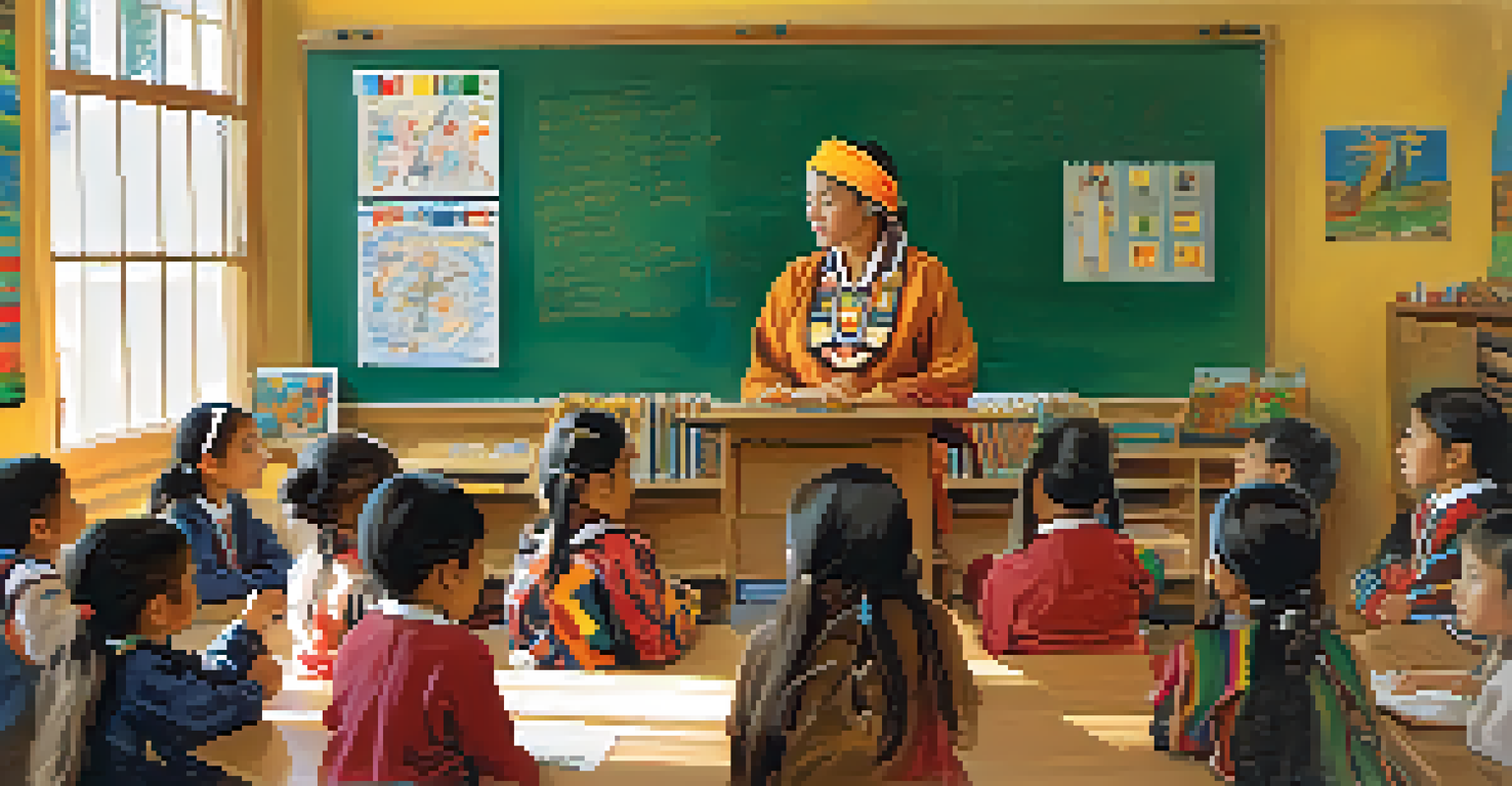Sacramento's Indigenous Languages: A Historical Overview

Introduction to Sacramento's Indigenous Languages
Sacramento is home to a rich tapestry of Indigenous languages that reflect the diverse cultures of the Native American tribes in the region. These languages are more than just communication tools; they carry the history and traditions of the people who have lived in this area for thousands of years. Understanding these languages offers insights into their worldviews and ways of life, emphasizing the importance of preserving linguistic heritage.
Language is the road map of a culture. It tells you where its people come from and where they are going.
Historically, the Sacramento Valley was inhabited by several tribes, including the Nisenan, Miwok, and Patwin, each with its own unique language. Sadly, many of these languages faced decline due to colonization and forced assimilation, which led to a significant loss of linguistic diversity. However, efforts have emerged in recent years to revitalize the languages, highlighting the resilience of Native American cultures.
In this article, we will explore the historical context of these Indigenous languages, their significance, and the ongoing efforts to preserve them. By shedding light on this topic, we aim to foster a greater appreciation for the linguistic heritage that enriches Sacramento's cultural landscape.
The Nisenan Language: A Glimpse into the Past
The Nisenan language, spoken by the Nisenan people, is one of the primary Indigenous languages of the Sacramento region. It is part of the larger Penutian language family and has several dialects that reflect the geographical diversity of Nisenan territory. This language not only serves as a means of communication but also encapsulates the tribe's connection to the land and its history.

Unfortunately, the Nisenan language faced significant decline due to external pressures, including the Gold Rush and subsequent displacement. Today, there are ongoing efforts to document and revitalize the language, with community members working to teach younger generations. This revival is crucial for maintaining the cultural identity of the Nisenan people and ensuring that their stories and traditions continue to thrive.
Revitalizing Indigenous Languages
Efforts to document and teach Indigenous languages in Sacramento are crucial for preserving cultural identity and heritage.
Additionally, language revitalization initiatives often include workshops, language classes, and collaborative projects with linguists. These efforts not only promote the Nisenan language but also foster a sense of community and pride among its speakers, helping to bridge the gap between past and present.
The Miwok Language: Preservation and Revitalization
The Miwok language is another vital Indigenous language historically spoken in the Sacramento area. Like the Nisenan, the Miwok language belongs to the Penutian family and is rich with cultural significance. It includes several dialects, reflecting the varied environments that Miwok tribes inhabited, from the Sierra Nevada to the Central Valley.
The preservation of our own culture does not require contempt or disrespect for other cultures.
Despite facing similar challenges as other Indigenous languages, efforts to preserve the Miwok language have gained traction in recent years. Community-driven initiatives, such as language classes and cultural events, are being organized to engage younger generations. These programs aim to instill a sense of pride and identity while also equipping participants with the skills to speak and understand their ancestral language.
The revitalization of the Miwok language is not just about words; it's about reclaiming a culture and heritage that has endured through adversity. By fostering connections to their linguistic roots, the Miwok community is reclaiming their narrative and strengthening their ties to the land and each other.
The Patwin Language: A Cultural Legacy
The Patwin language, spoken by the Patwin tribe, is an essential part of Sacramento's Indigenous linguistic heritage. This language, like its counterparts, is a key to understanding the culture, traditions, and history of the Patwin people. The language's structure and vocabulary are deeply connected to the tribe's relationship with their environment and way of life.
Much like the Nisenan and Miwok, the Patwin language has seen a decline in speakers over the years due to historical events. However, recent revitalization efforts have focused on documenting the language and teaching it within the community. These initiatives are crucial for keeping the Patwin language alive and ensuring that the knowledge embedded in it is passed down to future generations.
Technology Aids Language Learning
Modern tools like apps and social media are being used to engage younger generations in learning Indigenous languages.
Furthermore, many Patwin community members see language revitalization as a pathway to cultural resurgence. By learning and using their ancestral language, they are strengthening their identity and fostering a sense of belonging, helping to ensure that their cultural legacy endures.
The Role of Language in Cultural Identity
Language plays a vital role in shaping cultural identity, serving as a vehicle for expressing values, beliefs, and traditions. For Indigenous communities in Sacramento, their languages are deeply intertwined with their history and sense of self. When a language fades, so does a part of the community's cultural richness, leading to a loss that extends beyond words.
The revitalization of Indigenous languages in Sacramento is not just an academic endeavor; it's a movement aimed at reclaiming identity and heritage. Community members are increasingly recognizing the importance of languages as a means of cultural expression and connection. Language classes, storytelling sessions, and cultural workshops are becoming common spaces for individuals to reconnect with their roots.
Through these efforts, Indigenous peoples are reaffirming their place in the world and their right to exist as distinct cultures. By embracing their languages, they are not only preserving their past but also shaping a future where their voices can be heard and celebrated.
Modern Technology and Language Revitalization
In today’s digital age, technology plays a significant role in language revitalization efforts. Online platforms, mobile apps, and social media are being harnessed to teach and promote Indigenous languages in engaging ways. This innovative approach allows younger generations to connect with their heritage using tools they are already familiar with, bridging the gap between tradition and modernity.
For example, some communities have developed language-learning apps that incorporate audio recordings from fluent speakers, making the learning process interactive and accessible. Social media campaigns also help raise awareness about the importance of Indigenous languages, inspiring both Indigenous and non-Indigenous individuals to engage with these rich linguistic traditions.
Cultural Identity through Language
Language is essential to cultural identity for Indigenous communities, intertwining history, values, and traditions.
By leveraging technology, communities are not only preserving their languages but also fostering a broader appreciation for cultural diversity. This integration of modern tools into traditional practices highlights the adaptability and resilience of Indigenous cultures as they navigate the complexities of contemporary society.
Conclusion: The Future of Indigenous Languages in Sacramento
The future of Indigenous languages in Sacramento is both hopeful and challenging. While many languages have suffered due to historical injustices, the resurgence of interest and commitment to revitalization offers a promising path forward. Communities are coming together, sharing knowledge, and empowering the next generation to take pride in their linguistic heritage.
As we reflect on the historical overview of these languages, it becomes clear that preserving them is not just about maintaining communication; it’s about honoring the cultures and histories they represent. Through continued efforts, the stories, traditions, and wisdom embedded in these languages can be safeguarded for future generations.

Ultimately, the revival of Indigenous languages in Sacramento is a testament to the resilience of Native American communities. By reclaiming their languages, they are not only preserving their past but also shaping a vibrant cultural future that celebrates diversity and fosters understanding among all.